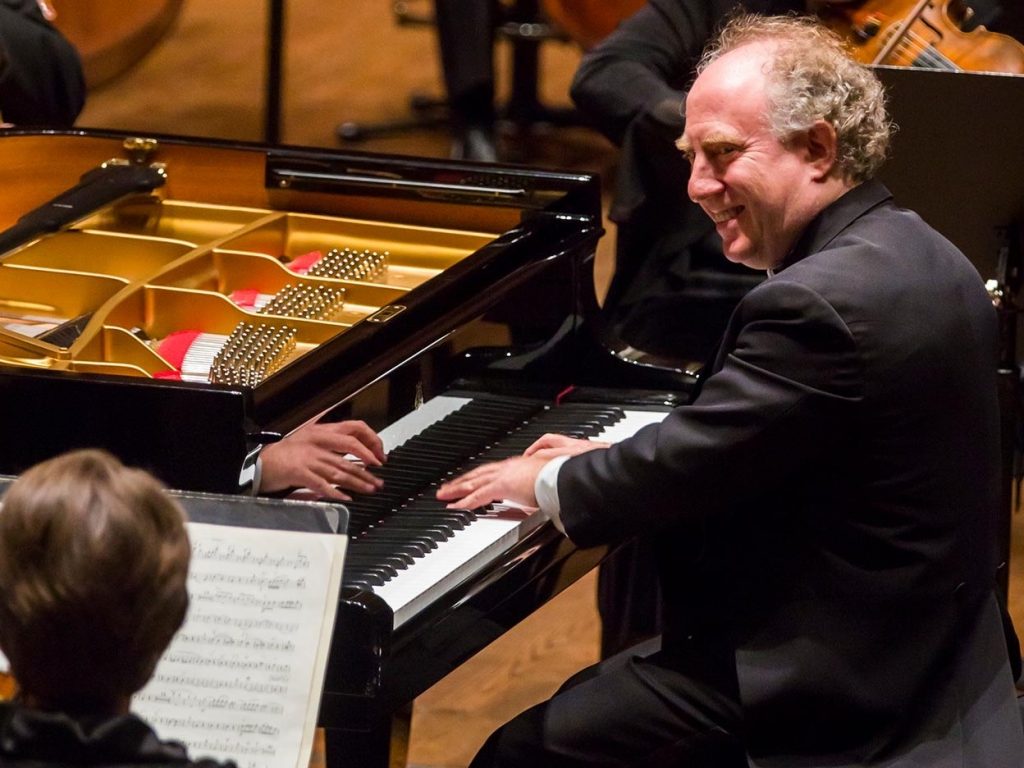Kahane, Philharmonic prevail over Geffen acoustic and coughing audience

The New York Philharmonic’s first concert of 2020 began with a sound that would have jolted anyone out of their holiday stupor. The opening chord of Mozart’s Piano Concerto No. 22 in E-flat, K. 482, emerged mushy, trebly, and as unpleasant as a mohair sweater on a sunny summer afternoon in Phoenix. Of all the bad sonic moments one has heard in the acoustic of David Geffen Hall over the years, this was the worst.
Jeffrey Kahane was the soloist and the evening’s conductor, leading the orchestra from the piano in the concerto. After intermission, the Philharmonic played Trittico botticelliano, by Respighi, and Haydn’s “Miracle” Symphony No. 96. These were elegant and vivacious performances, musically satisfying, though the experience continued to be marred by sound problems, both of the acoustic and from the audience.
The strings sounded separated from the rest of the ensemble and filtered through the scratchy soundtrack to some sepia-toned haze of a tequila hangover. When Kahane entered in the concerto, the change in timbre was a pleasure in and of itself from the flattened sound of the orchestra.
As was his playing. Conducting from the piano is often problematic, with the soloist unable to integrate their solo playing and the concepts they are trying to convey via conducting.
This was assuredly not the case Friday night. As a conductor, what Kahane conveyed most strongly was spirit, not just physical vitality but committed, collaborative music making. Orchestral statements set an antiphonal frame around the solo part; the Philharmonic played Mozart’s phrases with an orderly, logical shape, while Kahane pushed and pulled his lines, using subtle and effective rubato and emphasis to put his personal stamp on the music. He played with the orchestra, they played with him.
His pianism was full of style. There were neither exaggerations nor flourishes, but the pervading sensation that Kahane loved the music. That joy came through both his playing and that of the accompaniment.
Instrumental balances improved in the second movement, and the sound deepened. Kahane played his own cadenzas in the first and last movement. They were lovely and seamlessly integrated with Mozart’s structures. The feeling that pianist and orchestra were playing together gained meaning as the timpani responded during the first movement cadenza with the first theme of the movement.
The sound in Respighi’s musical depiction of three Botticelli paintings was also a vast improvement over the first half. The orchestra was transparent, three-dimensional, each color highlighted while contained within the sonic whole. This indicated that Kahane, while no stranger to this space, simply has not had the cumulative experience that music director Jaap van Zweden has had to find the right balances in each piece the Philharmonic plays.
Respighi was the Technicolor composer of the 20th century, and his sonifications of scenery are the equivalent of swashbucklers like The Adventures of Robin Hood—entertaining, sociable, full of color and fun, but somewhat insubstantial. One remembers enjoying the thing as it went along, but can’t recall the sensation.
Trittico botticelliano is like that. This was a superb performance in that one relished the playing, especially the solo passages from bassoonist Judith LeClair, clarinetist Anthony McGill, and flutist Robert Langevin, who had an exquisite, rounded, full tone Friday. From measure to measure, this was enjoyable, and it furthered the amiable warmth between Kahane and the orchestra.
The most impressive music was the piquant tendrils that drift away at the end of the concluding, “La nascita di Venere” movement. Unfortunately, that was ruined Friday night by someone’s phone ringing—loudly, with an insipid electronic tune, while the orchestra was still playing the final notes.
Unpleasant, but apt in a perverse context. The flow of the concert had already been interrupted in each piece by coughing that was comically excessive. It also presented itself as something obligatory, not just a part of the concert ritual or a bronchial necessity but with the attitude that it was something the audience deserved after sitting through each movement.
Kahane clearly planned on only momentary pauses between movements, and had to force through direct segues from the middle movement of the concerto into the last, as well as from the Menuetto and Trio to the Finale in Haydn’s Symphony No. 96. He also appeared exasperated over the phone ringing, and said something to concertmaster Frank Huang before turning to acknowledge the applause.
The first movement of Haydn’s symphony had similar sound problems to those that opened the concert, though not quite as bad. And, as in the piano concerto, the orchestra’s sound broadened, deepened, and grew more colorful as the music went on.
And like the Mozart, this was a fine ensemble performance, full of energy and charm. A welcome mark of the interpretation was the surprising amount of sturm und drang darkness that came out of the fugue in the Andante movement. One imagined it was a little bit of personal revenge over the disruptions, the musicians relishing something for themselves since so many members of the audience weren’t all that into it. For the attentive listener, it was a pleasure.
This program will be repeated 2 p.m. and 8 p.m. Saturday and 7:30 p.m. Tuesday. At the Saturday matinee Brahms’ Piano Quintet replaces the Mozart concerto. nyphil.org
Posted Jan 05, 2020 at 10:43 am by DorothyT
We attended last night, Saturday, sat in row X and found the orchestra’s performance, Kahane’s conducting, and the sound in the hall to be wonderful. We’d like to go again on Tuesday. The Respighi hasn’t been performed by the NY Philharmonic since 1932 according to the program. Kahane and the orchestra brought out the colors of each piece beautifully.